
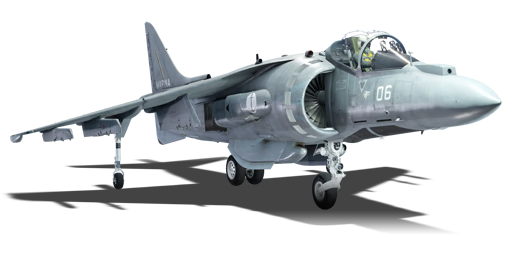


In 1989, Italy's ban on using fixed-wing aircraft in naval aviation was finally lifted and, without missing a beat, Italy signed a contract the following year for the purchase of 14 AV-8B+ VTOL fighters and 2 TAV-8B trainers for use aboard their Giuseppe Garibaldi-class aircraft carrier. Three Harriers were built in the US and delivered to Italy before their first deployment on a peacekeeping mission to Somalia in 1995; all subsequent orders were assembled from kits domestically by Alenia Aeronautica. The Harrier IIs would form the backbone of Italian naval aviation in the modern era, being modernised for operations aboard the new Cavour-class carrier and soon the upcoming Trieste carrier, where they will be supplemented in the VTOL strike role by F-35B Lightning II fighters.
The Italian AV-8B Plus, introduced in Update "Sons of Attila", is a modernised version of the venerable AV-8 Harrier, bringing it up to fourth-generation fighter standards. The upgrades allow this aircraft to not only carry a plethora of new guided ordnance, targeting systems, protective measures, and advanced air-to-air missiles, but the airframe itself was heavily upgraded over previous AV-8s, with a more powerful engine and large leading edge extensions, allowing the Harrier II to manoeuvre swiftly in ways its predecessors could only imagine.
The AV-8B+ is an incredible all-rounder for Italy at high ranks: it proves a decent support fighter in dedicated air battles, but truly shines in mixed battles. With the capability to carry up to ten laser-guided GBU-12 bombs, in addition to a LITENING II thermal pod, a GAU-12/U rotary cannon, and two AIM-9Ms for self-defence, the AV-8B+ can absolutely decimate ground forces when left unchecked over a battlefield. Other ordnance options on the AV-8B+ include up to four AGM-65D Mavericks or the larger GBU-16 laser-guided bombs, as well as a wide array of unguided bombs and rockets. The aircraft also has many tricks up its sleeve due to being a VTOL: in air engagements, the act of "VIFF"ing, or "Vector In Forward Flight", allows the Harrier II to quickly force an opponent to overshoot while also tightening its own turning circle through the use of VTOL thrust vectoring. In ground battles, while a risky manoeuvre that requires preparation, it is possible to use the AV-8B+ similarly to a helicopter: by hovering behind terrain cover and only popping out occasionally to launch fire-and-forget AGM-65D Maverick missiles at unsuspecting tanks.
flaps
flaps
flaps
brake
| Name | Weight | Slot | ||||||||
|---|---|---|---|---|---|---|---|---|---|---|
| 84.5 kg | 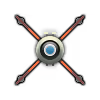 |  |  |  | ||||||
| 84.5 kg |  |  |  |  | ||||||
| 117.9 kg |  |  | ||||||||
| 138.3 kg |  |  | ||||||||
| 240.9 kg |  |  | ||||||||
| 254 kg | 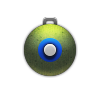 |  | ||||||||
| 235.9 kg |  |  | ||||||||
| 147.9 kg |  |  |  |  | ||||||
| 226.8 kg | 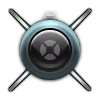 |  |  |  | ||||||
| 303.5 kg |  |  |  |  | ||||||
| 7 × | 144.6 kg | 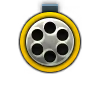 |  |  |  | |||||
| 7 × | 160.5 kg | 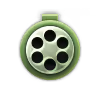 |  |  |  | |||||
| 38 × | 459.3 kg | 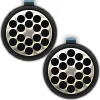 |  | |||||||
| 8 × | 560.6 kg |  |  | |||||||
| 253.1 kg | 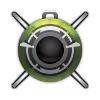 |  |  |  | ||||||
| 2 × | 506.2 kg | 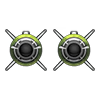 |  | |||||||
| 2 × | 554.3 kg | 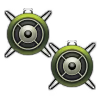 |  | |||||||
| 495.3 kg | 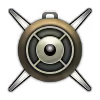 |  |  |  | ||||||
| 3 × | 353.7 kg | 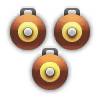 |  |  |  | |||||
| 3 × | 414.9 kg |  |  |  |  | |||||
| 3 × | 722.7 kg | 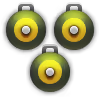 |  |  |  | |||||
| 3 × | 762 kg |  |  |  |  | |||||
| 446.8 kg |  |  | ||||||||
| 2 × | 471.8 kg | 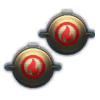 |  |  |  | |||||
| 57 × | 688.9 kg | 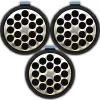 |  | |||||||
| 12 × | 840.8 kg |  |  | |||||||
| 3 × | 759.3 kg | 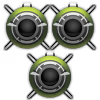 |  | |||||||
| 3 × | 831.4 kg | 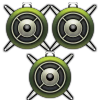 |  | |||||||
| 2 × | 893.6 kg | 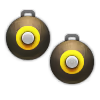 |  | |||||||
| 257.8 kg | 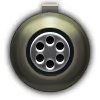 | |||||||||
| 2 × | 235.8 kg | 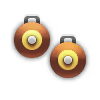 | ||||||||
| 2 × | 276.6 kg | 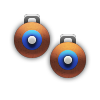 | ||||||||
| 2 × | 481.8 kg | 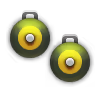 | ||||||||
| 2 × | 508 kg | 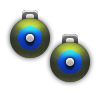 | ||||||||
| LITENING II targeting pod | 208 kg | 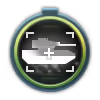 | ||||||||












Flight performance | |
|---|---|
Survivability |
|---|
Weaponry | |||
|---|---|---|---|